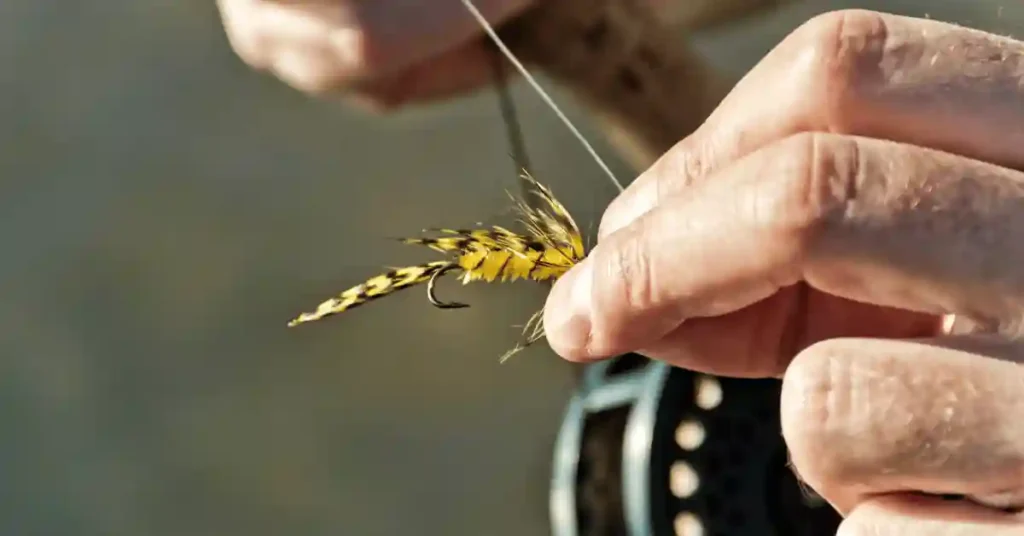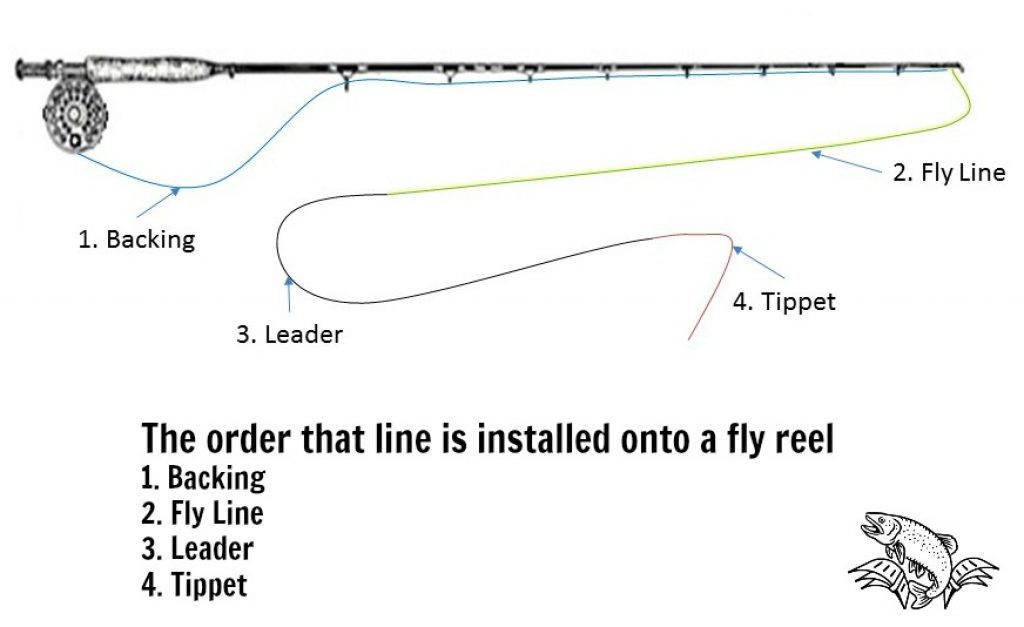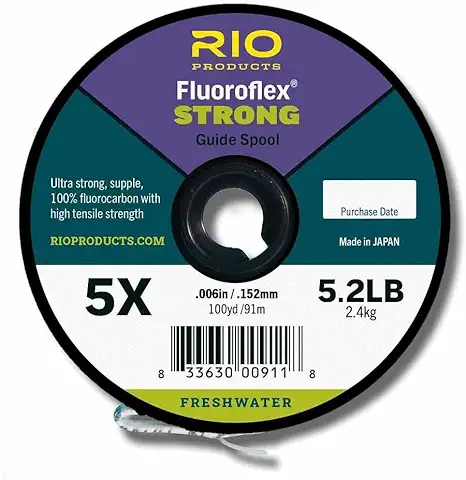Understanding Fly Fishing Leaders and Tippets? Expert Guide (2024)

At first glance, fly fishing leaders and tippets seem straightforward: a tapered leader followed by a thin tippet for precise casting, delicate fly presentation, and minimal drag during drifts.
Despite the apparent simplicity, many novice fly fishermen may not fully grasp the multitude of options and intricacies involved in selecting the right setup for different situations. Whether you’re new to leaders and tippet or an experienced fly fisherman, Don’t you are in the right place.
In this guide, we will discus Leader and tippets their sizes, material and how are they different from each other.
What Exactly are Fly Fishing Leaders And Tippets?
Fly fishing leaders and tippets are essential components of a fly fishing setup. The leader is a tapered section of monofilament or fluorocarbon line that is attached to the end of the fly line. Its primary purpose is to transfer the energy from the fly line smoothly to the fly, allowing for accurate and delicate presentations.
Leaders are typically thicker at the butt end (attached to the fly line) and taper down to a finer diameter at the tippet end. The tippet is the final, thin section of the leader, and it is where the fly is attached. Tippets are designed to be nearly invisible in the water, allowing for a more natural presentation of the fly.
Moreover, The leader’s section attaching to the fly line is usually on the heavier side of the pound test rating, known as the butt section. Many anglers begin with a 20-pound test butt section, tapering it down to around 4 pounds. An average leader length is about 9 feet, a good starting point for learning fly fishing basics. The ‘X’ rating, found in leaders like 4X or 5X, will be explained shortly.
Basic Arrangement of Fly Fishing
Understanding the concept of a leaders and tippets requires a basic grasp of the conventional fly-fishing arrangement. The components of a fly fish line include backing line, connected to a fly line, linked to a leader, attached to a tippet, and finally, fastened to your fly. Each element in this setup serves a specific purpose.

Backing – The initial type of fly wound onto your reel is the fly line backing, directly anchored to the reel’s arbor. Typically crafted from braided polyester, backing fills the reel and acts as a robust lifeline when grappling with sizable fish. While not strictly essential for fly fishing, it is recommended, especially in saltwater fly fishing scenarios.
Fly Line – Constituting the primary section of the fly-reel setup, the fly line is weighted to assist the angler in casting the line accurately to the target area. The fly line typically has a specific weight.
Leader – Following the weighted fly line is the leader, a tapered line that starts off at its thickest and gradually narrows down to the tippet. Its clear and thin nature prevents it from alarming fish that may be observing your fly.
Tippet – Serving as the terminal part of the fly line and the section to which attaches to your fly, the tippet is the thinnest segment of the fly setup. This thinness allows your fly to drift and move naturally on the water without creating disturbances that could spook the target fish.
Leader Vs Tippet?
Think of them as the dynamic duo in your fishing adventure.
First off, the leader material is like the backbone, connecting to your fly line. Picture it as a superhero cape, starting with a heavyweight of around 20 pounds. The ideal length for your leader is about 9 to 10 feet – a versatile choice that you can adjust based on the situation.
Now, here’s the mission: create a taper from the robust butt section to the slender tippet section. This tapering is crucial. It lets the energy from your fly line flow smoothly through the leader and tippet, helping your cast straighten out for a stealthy approach.
Imagine this: you begin with a 20-pound test leader, gradually taper it down, and voila! The last couple of feet host the tippet, your secret weapon to fooling those crafty fish without revealing your fishing line.
But hold on – crafting your own tapered leader with different pound tests can be a real challenge in just 9 feet. That’s where the art of hand-building custom leaders comes into play, a vast world of expertise. However, we’re keeping it simple here.
Head to your local fly shop, and you’ll find pre-built knotless tapered leaders – modern wonders! These gems offer the perfect taper without those pesky knots that might snag on weeds. Look for one around 7-9 feet in length, tapering down to 3X or 4X (more on the ‘X’ rating shortly).
Now, let’s talk ‘X.’ It’s not a mystery code but a rating system denoting the diameter of your tippet. So, when you’re out there, grab a knotless tapered leader, attach your preferred tippet size material (like 4X), and you’re all set. It’s easier than hand-building, and you’ll be casting like a pro in no time.
Fly Fishing Leader and Tippet – Setting Up
As we discussed earlier, the thicker leader material is connected to the end of the fly line in fly fishing. The recommended length for a beginner learning how to fly fish is typically around 9 or 10 feet, but this can be adjusted based on the fishing situation. The objective of setting up a leader is to create a gradual change in thickness from the thicker butt section to the thinner tippet section. This helps efficiently transfer the energy from the fly line, allowing it to straighten out effectively.
If you begin with a 20-pound test leader material attached to your fly line and gradually reduce its thickness, the final few feet of the leader will have the tippet attached. This setup provides the best chance to deceive the targeted fish without them noticing the line connected to the fly.
Tapering a leader from 20-pound test down to 6 or 4-pound test within just 9 feet can be challenging. Creating custom tapered leaders by hand is a broad and diverse topic, with various resources available online explaining different techniques and purposes. However, this post won’t delve deeply into that aspect.
Now, let’s talk ‘X.’ It’s not a mystery code but a rating system denoting the diameter of your tippet. So, when you’re out there, grab a knotless tapered leader, attach your preferred tippet size material (like 4X), and you’re all set. It’s easier than hand-building, and you’ll be casting like a pro in no time.
Tippet Material
When it comes to tippets, you have options, and the two main contenders are monofilament and fluorocarbon.

Monofilament
Monofilament, a classic choice, is a nylon material known for its durability and stretch. It’s a versatile option, suitable for various fishing needs. Ranging from 0X to 3X for streamer fishing and 4X to 6X for trout applications, it caters to different scenarios. If you’re aiming for extremely small flies or dealing with finicky fish, the 7X and 8X sizes come into play. Mono tippet is budget-friendly and offers effective floatation for delicate dry fly presentations.
Fluorocarbon
On the other hand, we have fluorocarbon, a stiffer, abrasion-resistant material. It excels in sun resistance and durability, making it a preferred choice for streamer and nymph fishing. Fluoro tippets sink faster due to their higher density. While less visible underwater, they come at a higher price compared to monofilament.
Wire
Now, for those toothy critters, enter wire tippet. Reserved for species with sharp teeth, this specialized tippet ensures your leader doesn’t get shredded. Available in 20lb, 30lb, and 40lb, it doesn’t follow the typical sizing chart, offering a specific solution for unique challenges.
Indicator
For nymph fishing enthusiasts, there’s the indicator tippet. Crafted for wet fly fishing without an indicator, it enhances visibility for tight line fishing. Acting as a short indicator section between your leader and final tippet, it creates a contrast that helps detect subtle changes in the line’s direction. Ideal for euro nymphing, it adds a unique dimension to your trout-catching endeavors.
Leader Material

A fly fishing leader is a fundamental component of a fly fishing setup, serving as the crucial connection between the main fly line and the fly itself. This leader plays a pivotal role in presenting the fly to the fish in a manner that mimics natural behavior, ultimately increasing the chances of a successful catch. The materials used in constructing fly fishing leaders contribute significantly to their performance and effectiveness.
Monofilament Nylon
Monofilament nylon is among the most commonly utilized materials for constructing fly fishing leaders. Renowned for its high strength, flexibility, and resistance to abrasion, monofilament leaders exhibit excellent knot strength, making them reliable in various fishing scenarios. This material is versatile and finds application in both freshwater and saltwater environments.
Fluorocarbon
In recent years, fluorocarbon leaders have gained popularity due to their unique properties. Fluorocarbon is virtually invisible underwater, making it an excellent choice for situations where fish may be easily spooked. Additionally, its higher density allows it to sink more quickly, making it suitable for specific angling conditions. As a result, fluorocarbon leaders are often favored in clear water situations and when pursuing species known for their wariness.
Braided Leaders
Braided leaders represent another category, constructed by intertwining multiple strands of material. This design imparts increased strength and flexibility to the leader, offering a more delicate presentation and reducing memory coils. Braided leaders find favor among anglers, especially in situations where a subtle presentation is critical, such as in calm, clear water.
Furled Leaders
Furled leaders, on the other hand, are crafted by twisting together multiple strands of material to create a tapered leader. These leaders offer a smooth transfer of energy during casting, resulting in a gentle and accurate fly presentation. Furled leaders are particularly appreciated by dry fly anglers seeking precision in their casting.
Tapered Leaders
Tapered leaders, characterized by a gradual decrease in diameter from the thick butt section to the thin tippet end, are widely used in various urban fly fishing scenarios. These leaders provide excellent energy transfer during casting, aiding in accurate fly placement. Tapered leaders come in various designs, each tailored to specific types of flies and fishing conditions.
Tippet Sizes
First things first, forget about breaking strength; we’re diving into diameters here. Manufacturers keep things consistent, so every 4X tippet, for instance, is .007 inches in diameter. But here’s the twist: the breaking strength can vary. One brand’s 4X might snap at 6.4lb, while another’s hits 7lb. And hey, some might even offer higher break strength for the same diameter – fancy, right?
Now, brace yourself for some numerical wizardry. As the “X” number climbs, the diameter and strength take a nosedive. Picture it like this: 7X is the skinny ninja, with a smaller diameter and less muscle, compared to the beefier 2X.
Now, here’s the cool-kid trivia to drop on your fly fishing pals. The “X” tippet size follows the magic of 11. It’s a scale where the “X” size and the tippet diameter always add up to 11. For instance, 4X tippet with a .007″ diameter (because 4 + 7 = 11). Or, if you’re pondering over 6X tippet and clueless about the diameter, just subtract 6 from 11, and voila – it’s .005″.
Recommended:
Rio’s Powerflex 4X Tippet – Buy at Amazon
Rio’s Powerflex Plus 4X Tippet – Buy at Amazon
Length
The length of your tippet is like the Goldilocks zone for fishing – it depends on where you are. For warm-water champs like bass or saltwater buddies, a 6-8ft leader is the norm, flaunting a final 12 inches as the tippet VIP. If you’re dipping into petite trout streams with minimal casting acrobatics, slap on a 2-foot encore to a 7.5ft leader.
Now, in the realm of medium-sized trout habitats with lively riffles, a 7.5-9ft leader with a 12-inch tippet cameo is the star. The riffles break up your tippet’s visibility, giving you a pass for a shorter length. The crowd-pleaser in terms of length? A 9ft leader with a 12-18 inch tippet, a swiss army knife for most trout streams. But, if you’re waltzing with lake trout or treading serene river stretches where your line plays hide-and-seek, go big with an 11-13ft leader and an 18–24inch tippet tail. When fish turn into tippet detectives, extend your tippet up to 4ft for that extra undercover vibe.
Function
Think of your tippet as the unsung hero extending your leader’s lifespan. With just a 12-inch boost, you’re the maestro changing flies without diving into the leader’s core. When the tippet’s on a short leash, snip it off, and a fresh section steps in.
Beyond the life-extension gig, tippet moonlights as the stealth artist for the elusive fish. No fish psychologist here, but if they’re spooked, play detective. Extend or downsize your tippet until you find that invisible sweet spot. Another tippet encore? Adding a trailing star to your already tied ensemble. Whether it’s a hopper hitching a dropper or a midge doing a color swap dance, the tippet takes a bow for versatility!
Leader Sizes
A fly fishing leader is a fundamental component of a fly fishing setup, serving as the crucial connection between the main fly line and the fly itself. This leader plays a pivotal role in presenting the fly to the fish in a manner that mimics natural behavior, ultimately increasing the chances of a successful catch. The materials used in constructing fly fishing leaders contribute significantly to their performance and effectiveness.
Diameter
One of the primary considerations when selecting a leader size is its diameter. Leaders are tapered, meaning they gradually decrease in diameter from the thicker butt section (attached to the fly line) to the finer tippet section (connected to the fly). Thicker leaders are more suitable for larger and heavier flies, while thinner leaders are used for smaller, more delicate patterns.
Tippet Size
A 9-10 foot is a standard size for fly fishing. The tippet is the final and finest section of the leader, directly tied to the fly. Tippet sizes are designated by an “X” rating, with smaller numbers indicating thicker diameters. For example, 4X tippet is thicker than 6X. Matching the tippet size to the fly and fishing conditions is essential. Finer tippets are necessary for more selective or wary fish, while thicker tippets provide added strength for larger species.
Length
Fly fishing leaders are available in various lengths, typically measured in feet. The length of the leader affects the way the fly behaves in the water. Longer leaders are suitable for clear, calm conditions, allowing for a more delicate presentation. Shorter leaders are preferable in windy or turbulent waters, providing better control during casting.
Leader Classifications
Leaders are often categorized by their overall size, such as 0X, 1X, 2X, and so on. The “X” system corresponds to the tippet diameter, with smaller X values representing thicker diameters. Anglers can choose the appropriate leader class based on the size of the flies they intend to use and the type of fish they are targeting.
What Is the Difference Between the Leader and Tippet?
Now, a common question arises: where does the leader end, and the tippet begin? Well, the tippet is actually part of the leader, specifically the last 1.5-2.5 feet. Packaged leaders follow a formula, often 60% thicker diameter (the butt section), 20% thinner material (the mid-section), and the last 20% as level tippet. This formula ensures a smooth energy transfer from the fly rod to the fly line, the leader, and finally, the fly.
So, there you have it – the symphony of fly fishing components working together, with the tippet playing a crucial role in the grand performance.
Can you fly fish without a tippet?
Absolutely, you can dive into fly fishing without tippet.
In the grand orchestra of fly fishing, leaders and tippet play the lead roles. Now, if you restrict yourself to just using fly fishing leaders, brace for a costly journey. Why? Well, here’s the deal: all fly leaders rock a sleek taper, starting thick at the butt and tapering down to a slender end. As you snip and tie on those dazzling flies, your leader gets shorter, inching closer to that thick butt section. Picture this: your leader becomes so beefy that tying on a fly becomes a no-go.
Now, here’s where tippet swoops in as the hero. It steps up to rebuild the taper, offering those thin sections for your fly-tying delights. But, yes, you can fly fish without tippet – it’s doable. Yet, I’d toss a nugget of wisdom your way: for the sake of ease and saving those precious dollars, why not embrace the convenience of tippet?
Final Words
As we wrap up our journey into the world of fly fishing leaders and tippets, I hope this article helped you understand these important tools a bit better. Just like choosing the right bait or finding the perfect spot, picking the correct leader and tippet is key for a successful fishing trip.
Remember, even if you’re just starting out in fly fishing, leaders and tippets play a crucial role in making sure you catch that big one. They’re like the secret sauce that helps you connect with the fish. So, the next time you head out with your fishing gear, think about what you’ve learned here, and you might just find yourself reeling in a great catch.
As you get ready for your next fishing adventure, keep practicing your casts, pay attention to your presentations, and most importantly, enjoy the experience. Fishing is not just about catching fish; it’s about the memories you make along the way. So, happy fishing, and may you have many tight lines in your future fishing endeavors!

Meet Ibrahim Khan, an avid angler and author in Fishing Teach. He shares his wealth of knowledge from his 16 years of experiences in fishing. His articles are a captivating blend of practical insights and thrilling tales that invite readers into the enchanting world of fishing.
Ibrahim’s guides are your go-to guide in the realm of fishing on this informational site. Hailing from a coastal paradise, Ibrahim’s passion for angling is the heartbeat of his life.
